2013 MacBook Air: PCIe SSD and Haswell ULT Inside
by Anand Lal Shimpi on June 10, 2013 10:01 PM EST- Posted in
- Mac
- Storage
- SSDs
- Apple
- MacBook Air
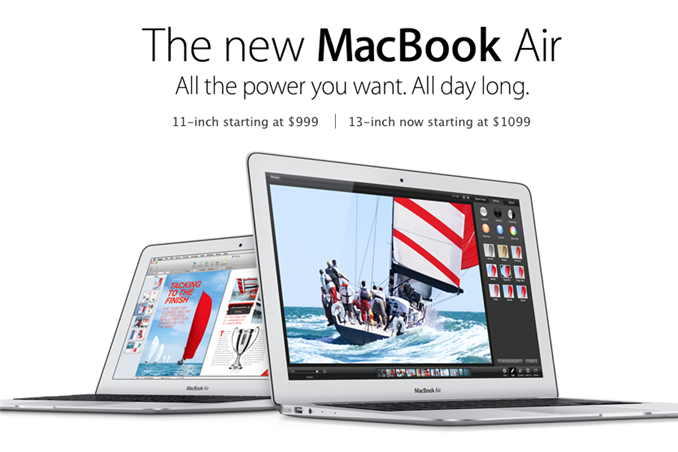
This morning Apple updated its MacBook Air to Intel's Haswell ULT silicon. The chassis itself didn't get any updates, nor did the displays. Both the 11 and 13 inch models retain their non-Retina 1366 x 768 and 1440 x 900 displays. There's a slight increase in battery capacity. The 11-inch model moves to 38Wh (8.6%) while the 13-inch model goes to 54.4Wh (8.8%). The big changes however are on the CPU, NAND and DRAM fronts.
With the new MacBook Air, Apple moves to a Core i5-4250U. The base clock drops to 1.3GHz across all of the models, but max turbo remains at 2.6GHz. Although the base clock is lower, I wouldn't expect substantially lower performance since the max turbo is unchanged as is the chassis that has to dissipate the thermals. To confirm, I ran a couple of Cinebench tests and generally found performance similar to that of last year's models:
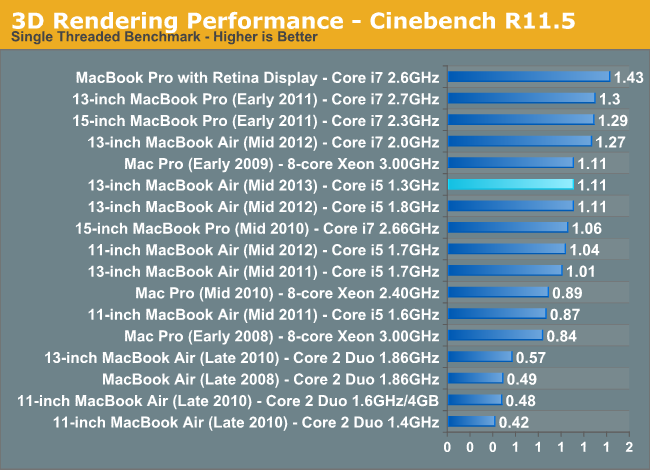
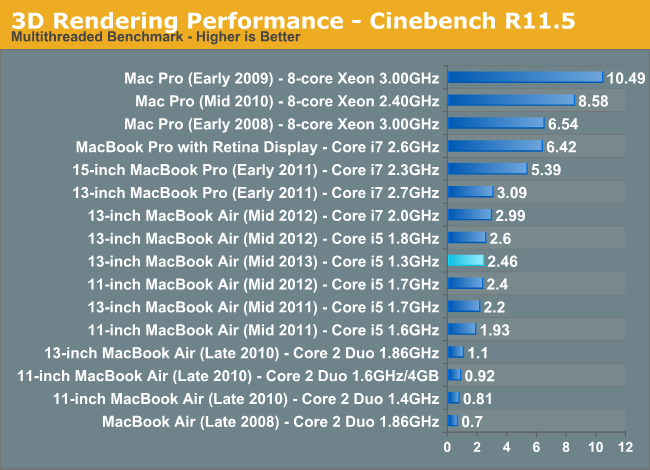
The 1.8GHz i5 in the 13-inch ended up being a bit quicker than the 1.3GHz 4250U this generation in the multithreaded test, but in single threaded performance the two are equal. The impact on the MT test is about 5%, it's there but not substantial. Don't be fooled by base clock, it's the combination of base clock, max turbo and cooling solution that'll determine performance here. As we found in our Haswell ULT review, CPU performance isn't something you can expect to see more of with Haswell vs. Ivy Bridge in these low wattage platforms.
You can get a 1.7GHz Core i7 upgrade with a 3.3GHz max turbo (i7-4650U). Both parts have Intel GT3 graphics clocked at a max of 1GHz on the i5 and 1.1GHz on the i7. Since the max GPU clocks are south of 1.2GHz, this is officially Intel's HD 5000 graphics and not Iris despite using the same silicon. The GPU base clock drops from 350MHz down to 200MHz, which should help reduce idle power consumption.
| 2013 MacBook Air Lineup | ||||||
| 11.6-inch | 11.6-inch (high-end) | 13.3-inch | 13.3-inch (high-end) | |||
| Dimensions |
H: 0.11-0.68" (0.3-1.7cm) W: 11.8" (30cm) D: 7.56" (19.2cm) |
H: 0.11-0.68" (0.3-1.7cm) W: 12.8" (32.5cm) D: 8.94" (22.7cm) |
||||
| Weight | 2.38 lbs (1.08kg) | 2.96 lbs (1.35kg) | ||||
| CPU | 1.3GHz dual-core Core i5 | 1.3GHz dual-core Core i5 | ||||
| GPU | Intel HD 5000 | |||||
| RAM | 4GB LPDDR3-1600 | |||||
| SSD | 128GB PCIe SSD | 256GB PCIe SSD | 128GB PCIe SSD | 256GB PCIe SSD | ||
| Display Resolution | 1366 x 768 | 1440 x 900 | ||||
| Ports | Thunderbolt, 2x USB 3.0, headphone jack | Thunderbolt, 2x USB 3.0, SD card slot, headphone jack | ||||
| Price | $999 | $1199 | $1099 |
$1299 |
||
On the storage front, Apple officially leads the charge with the move to PCIe based SSDs. The upcoming Mac Pro, as well as the new MacBook Airs both use PCIe based SSDs instead of SATA drives. A quick look at OS X's system profiler reveals a PCIe 2.0 x2 interface, capable of 1GB/s in each direction.
The drive in my system uses a Samsung controller, although I've heard that SanDisk will have a PCIe solution for Apple as well. A quick run through Quick Bench reveals peak sequential read/write performance of nearly 800MB/s:
This is a pretty big deal, as it is probably the first step towards PCIe storage in a mainstream consumer device that we've seen. I'm still awaiting official confirmation as to whether or not this is an M.2 based solution or a proprietary connector. Update: It's a custom Apple design, not M.2. Since there's no PCIe routed off of the CPU in Haswell ULT, these 2 lanes come from the on-package PCH.
The other big change is the move from DDR3L to LPDDR3, a new feature supported by Haswell ULT. I need to go back and dig through the Haswell ULT datasheets again, but I believe the total memory interface width remains at 128-bits wide even if you use LPDDR3 - you just get lower power consumption.
Obviously battery life is the biggest improvement here with the new MacBook Air. Thanks to Haswell's platform power optimizations, Apple claims up to 12 hours on a single charge for the 2013 13-inch MacBook Air. Given the improvements I saw in our Haswell ULT review, I don't doubt that we could see some very good numbers out of these notebooks.
I just got my hands on a 13-inch 2013 MBA and I'll be running performance tests (including the first look at Intel's HD 5000 graphics) over the coming days. I'm still traveling until Thursday but I'll do my best to run battery life tests while I'm on the road as well. More soon!


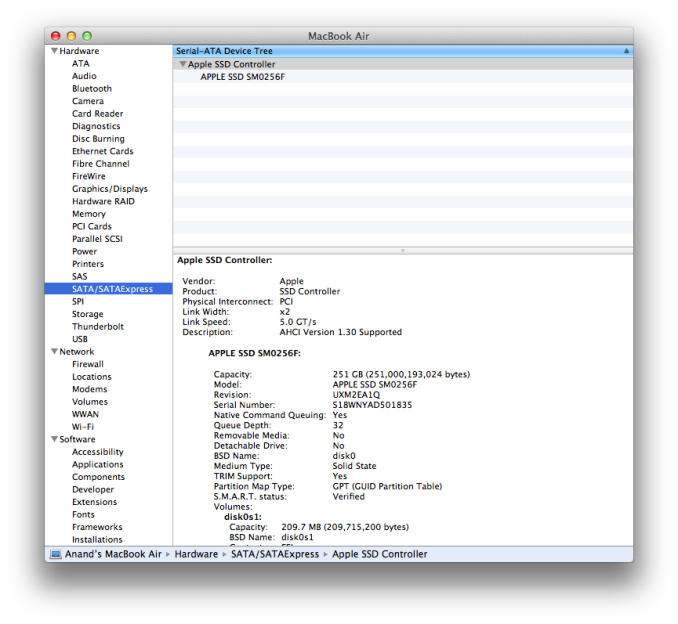

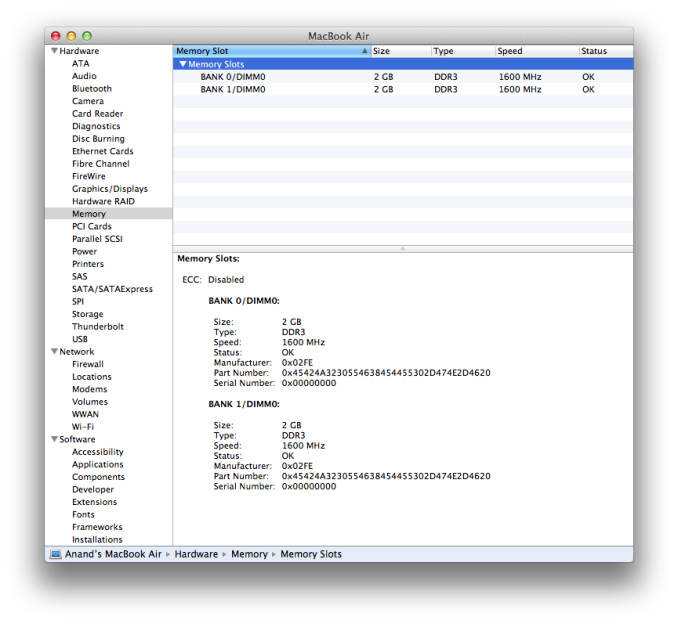








174 Comments
View All Comments
Bkord123 - Wednesday, June 12, 2013 - link
Thank you. I get it now!asendra - Tuesday, June 11, 2013 - link
Anand, or anyone really, do you know if those estimated battery times correspond to the macbook air with mountain lion installed, or with Mavericks?It should be with Mountain lion because Mavericks won't be available till Fall, but with all the battery improvements in Mavericks, I find hard to believe they could even improve those 12h when mavericks launches..
Elwe - Tuesday, June 11, 2013 - link
From the pictures/video posted on-line (the ones from CNET are as good as any, I guess--http://www.cnet.com/apple-macbook-air-13-inch/), the ones currently available are clearly OS X Mountain Lion (10.8.4) of some form. But there are two caveats to that:1) Apple could have (I would doubt it, but they did not make it clear) done these battery tests with a 10.9.x build, and mean for those numbers only to reflect Mavericks. Since Mavericks is not due to drop (for production use) for a while, I cannot imagine them not have some caveat or *.
2) Apple could have tweaked the base 10.8.4 to include some special Haswell goodness for the Air, and tide it over until 10.9. *If* they did either #1 or #2, I would find #2 much more likely. That they done this in the past both with Mac and iOS hardware. I have no idea how much trouble it would be to backport such things (there were a lot of new changes announced, and even more not discussed).
What I hope the situation is is that this is a standard 10.8.4 with the new Haswell chips and modern chipsets. And that Mavericks will just give us a bit more. Unlike some people that have posted, in this form factor I am not looking for much more power (cpu nor gpu) than the current line provides. I think the extra battery life is crazy helpful, though. Especially in the 11" inch one, where I was seeing more like four hours usage vs the five Apple sees (I do prefer 100% brightness vs 75% on these non-Retina screens, though). So let's say I would loose an hour (or even two hours) off the nine hour number from Apple . . . that still leaves me a good seven hours for the 11" model (and 10 for the 13" model). In something that is not ARM nor Atom based . . . that really is something, people.
Retina would have been nice, but I just do not see how (and did not last year) how they could do it in the form factor and at scale/cost. When they introduce the 13" Macbook Pro Retina just last year, I think we all saw the current state of what could be done in this price range/form factor.
For a "basic" SysAdm machine, I am really liking the 11". For a basic student or executive machine, I am really liking the 13". For power users, let's wait until the fall.
asendra - Tuesday, June 11, 2013 - link
I thought of the possibility of them porting some of those features to a special 10.8.4 version for this airs, but the changes are really low level stuff, I really don't think it would be reallistically feasible.SamuraiSausage - Wednesday, June 12, 2013 - link
Elwe - Can you elaborate on why you might find the 11" a better option for a sysadmin over the 13"? As a sysadmin myself I am a bit torn over the two. The power and portability of the 11" intrigues me and while I could get over the comparatively lower battery life the 1366x768 resolution concerns me.Bkord123 - Tuesday, June 11, 2013 - link
Am I the only one in America that wonders why "Maverick" is pluralized? Sounds weird to me. 'Maverick' sounds right. OS X Maverick. What's the deal with the 's'?lhurt - Tuesday, June 11, 2013 - link
http://en.wikipedia.org/wiki/Mavericks_%28location...Bkord123 - Tuesday, June 11, 2013 - link
No kidding. I must have missed that part of the WWDC. Many thanks!tipoo - Thursday, June 13, 2013 - link
It ships with 10.8. Yeah, I really want to see what Mavericks can do, if it already gets 12:51 on a light load according to Engadget.fourthletter - Tuesday, June 11, 2013 - link
Mascbook Airs have been using PCI-E SSDs since they launched ! They bought the first run of Toshiba's PCI-E SSDs - Please do more research.